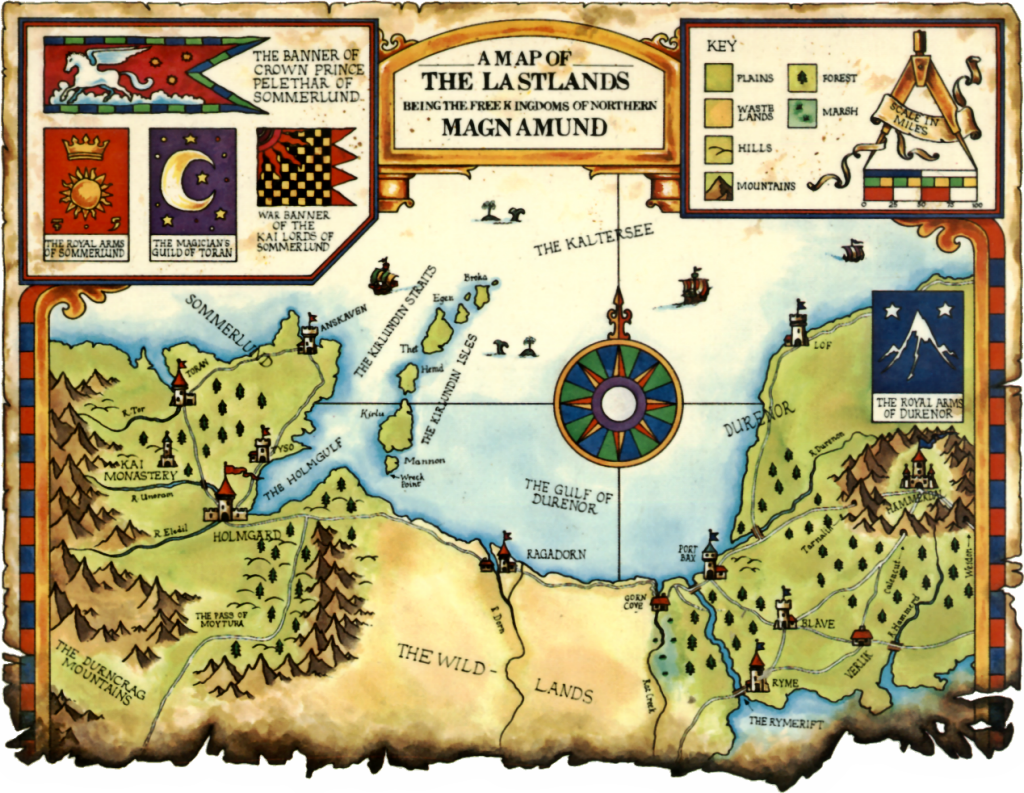ah, the deep lores
my favourite!
my favourite!















Team Introductions: Jan Pospíšil and Marcelo Orsi
I’m pleased to continue our team introductions with two of the more recent team members—which is to say, they’ve been working on
Fallen Gods
for many months rather than many years. Hailing from the Czech Republic and Argentina respectively, Jan Pospíšil and Marcelo Orsi spread our team even farther across the globe!
I first crossed paths with Jan way back in 2018, not long after he began work on
Six Ages: Ride Like the Wind
, when he generously offered to contribute some art to
Fallen Gods
. Since
King of Dragon Pass
was one of the important inspirations for
Fallen Gods
, and since Jan’s art is (and was) phenomenal, it was a wonderful offer to receive! Unfortunately, conflicts on both ends kept intervening, and it wasn’t until late 2022 that we finally were able to connect, and not until late 2023 that Jan had time to dig in more. Now he’s taking on one of the critical pieces of our art: the illustrations the player sees in the game’s many different endings. He also contributed a couple of event illustrations.
Marcelo and I met on Twitter, as his striking artwork for
There Is No Light
and
Inscryption
kept catching my eye (as well as James’s). It turns out Marcelo is as much a fan of our games as we are of his art, and we were all glad to find an excuse to collaborate. (Marcelo’s also helping on
Carbonflesh
with James.) Very quickly, we bonded over our shared love of Borges (an Argentine author who influenced
Primordia
’s characters and worldbuilding) and
asado
. So far, Marcelo has worked on assembling a lorebook for
Fallen Gods
from other artists’ material—an assembly process that benefits from Marcelo’s excellent artistic skill—and we’re looking forward to sharing
The World of Fallen Gods
soon. We also are looking forward to additional contributions from him in the game itself, such as beautifying the items, and in its manual.
Both Jan and Marcelo have amazing galleries that shouldn’t be missed!

Jan Pospíšil
Mark
: You’re best known for your work on
Six Ages
, another game that is grounded in mythology, folklore, and history—but a different set of influences for each. What steps did you take to make your
Fallen Gods
art capture the different setting?
Jan
: I played the game for a bit and looked at the existing art a lot. The overall visual language actually felt quite familiar, the challenge was mostly in adjusting my tools and process to produce similar-enough results. I definitely simplified my drawings compared to
Six Ages
, which was in a way quite liberating. There isn’t as much need for a ton of culture-specific details and other than the god there aren’t many recurring characters. Then it was a matter of keeping the color palette more muted than I did in
Six Ages
, as well as leaning into strong lighting setups rather than flat local color.

Mark
: Initially, you did a pair of event illustrations for
Fallen Gods
before taking on the ending illustrations. Are there any differences in approach you’ve taken to the endings?
Jan
: The endings definitely require more flash and drama—using both lighting and composition they need to feel impressive and final. It obviously depends on the nature of each ending, but the player should typically be feeling big emotions while looking at the painting. We meet strong important gods, prevail in battle over terrible monsters and see bright bridges of light shoot up into the heavens—the art needs to deliver that spectacle. In other cases we get just a landscape that has to communicate a certain mood, or half a character facing away from the “camera” or cut off by deliberate composition that needs to get their relationship to the god across.
In the end I think I just planned a bit better before I started and tried a little harder while I painted.

Marcelo Orsi
Mark
: What first attracted you to
Fallen Gods
?
Marcelo
: I think the atmosphere of the game was the first thing that hooked me in. It was something beyond just “retro,” which would imply something created now that wants to emulate something old... no, this game felt as if it was actually created in the past, in a period where I think games were truly magical. The art, the music, and the narration just transported me to that awesome era.
Then, the gameplay loop sealed the deal for me: it wasn’t just the atmosphere; this thing played as a classic game, too! It wasn’t obvious; I had to figure out how to win this thing. It was like a puzzle, something I kinda miss with the standardization of mechanics these days. That’s what I mean when I say it felt from that classics era: it was fresh, as games from back then were. After a few runs, I went from being interested in it to actually loving it.

Mark
: As an artist yourself, what do you look for in creating a book to showcase the diversity of illustrations within Fallen Gods?
Marcelo
: Well, the first thing I looked for was an element that would help me achieve some kind of cohesion. That’s when the UI of the game came into the scene: just had to adapt it and it would give me the forms I needed to link each illustration together, as well as the type for the text. This of course had to be modified to suit the new format, but the game already has that “book” feel, so it was an easy adaptation.
Now, for actually compositing everything, I treated each page as if it were an illustration that will now include the frames and the text: it needed focal points, and a flow. And most importantly: it needed to be clear to the reader... so even if I added some effects here and there to spice things up, I always tried to keep them subtle. The illustrations and text had to do the heavy lifting, my work just needed to frame them and enhance them without getting too much attention.










No schedule. I talk about my views on this around 49 minutes into the Cress interview. The game for sure could be released now, but it will be better when it's done (or, put otherwise, done when it's better). The luxury of this being a hobby.Do we have a schedule for release?
The codex playthrough made me think the game was almost done.



















Fallen Gods
This year marked a significant milestone for Fallen Gods, our longest-running project, now approaching its 11th year! While we’re not quite there yet, we’re in spitting distance. The core content and engine are firmly in place, meaning 2024 was about refining and adding the finishing touches. That included features such as the tutorial, ending slides, world map, quest log, scoreboard, and run summaries. Art-wise, we completed a major UI overhaul; refined, replaced, or added dozens of illustrations; and added pixel art for new combat animations, diagonal movement sprites, and map details. On top of that, we expanded the game with more events, music tracks, sound effects, and voice-over nodes, while enhancing the ambient soundscape.
There’s still a bit to go, but we’re committed to ensuring Fallen Gods is as polished as possible before we cross the finish line. One nice thing about the development of the project is that we’re not beholden to any timetable.















Remembering Joe Dever
Creator of Lone Wolf and an Inspiration
Today would have been the 69th birthday of Joe Dever, the late amazing writer and creator of the Lone Wolf series of game books (among other things). Anyone who has followed the long development of Fallen Gods knows that Lone Wolf was one of its core inspirations; not once, but twice, it had an important influence on me as a game designer.

I first discovered Lone Wolf in the 1980s when I was a kid, and I was enthralled. Dever’s writing and Gary Chalk’s art brought the world to life with spare, vigorous prose and evocative ink drawings.
As an avid consumer of all things fantasy, the books could have held me if they were nothing more than novels. But what really sank the hook was that they were structured somewhere between a Choose Your Own Adventure (which I loved) and Dungeons & Dragons (which I had struggled to connect with). If you haven’t played these gamebooks, you should because they have a particularly special quality seldom captured in computer games: the options you don’t take—whether the Kai Disciplines (super powers) or gear you forgo at the start, or the choices you opt not to take as the adventure progress—are as evocative as the ones you do take. Even after you’ve “won” a book it’s impossible not to pick it up and play it again and again. Over time, the character sheet was shredded from erasures, the spine broken, and nearly every page dog-eared... in book after book.

In fact, the first game I ever designed was a dice-driven gamebook called The Road to Doom’s Castle, laid out using The Print Shop on our Apple IIc and a borrower VeloBinder. (I imagine the clip art will be familiar to anyone of a certain age...) As homages to Lone Wolf go, it is a poor one (given the limited abilities of an 9-year-old), but it was one of my first steps on the road of game design, with Joe Dever pointing the way.

And then, video games and computer games caught up to Lone Wolf in storytelling, and I drifted away from gamebooks and into Gold Box and later Infinity Engine cRPGs, Sierra and LucasArts adventures, and every jRPG I could get my hands on. My designs and stories for Primordia, Strangeland, Infinity, and other games have their roots in those adolescent obsessions of mine. I probably never would have spared another thought for Lone Wolf, and never would have launched the great undertaking of Fallen Gods, except that Joe Dever did something else that showed what an amazing person he is.
In 1999, Dever authorized Project Aon to republish the Lone Wolf books, for free online. He wrote:
I would be especially pleased if my granting of the rights to distribute my books in this way was seen as my ‘millennium gift’ to all those devoted readers who have kept the Kai flag flying high, through all the good times, and the not-so-good. It would make me very proud indeed if this enterprise laid the foundations of a lasting legacy, securing the longevity of Lone Wolf by making my creation freely and readily accessible to current and future online generations.
(Gary Chalk, naturally, showed the same generosity and allowed his illustrations to be used as well.)
As a result, in 2005, the games were waiting for me to play again—without wearing out erasers or pages or spines in the process—and I consumed them avidly, enjoying that rare double-vision delight where you look through jaded and youthful eyes at the same time, and through both sets see something splendid. “Nostalgia” doesn’t explain it. The gamebooks are just damn good. The choices still have their impact. The balance remains excellent. The writing is still lean and muscular. The art is still fantastic. The world of Magnamund and the nation of Sommerlund remain as enthralling as ever.
Joe Dever’s generous heart is as much an inspiration as his creative mind—it’s one reason I’ve enjoyed releasing free games (and free content) to our fans whenever I can.
In whatever summerland his soul rests, I hope he knows that the lasting legacy of Lone Wolf left its DNA in Fallen Gods. “Blessed is the giver, richer through the giving of a gift.”







